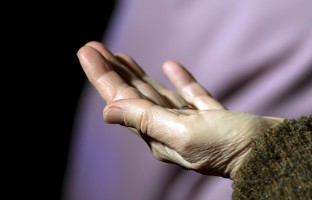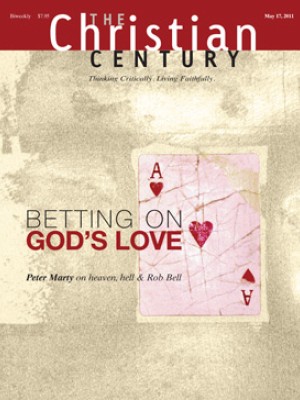Moving parts: Liturgical body language
More than 20 years ago when our son was seven years old, I took him to the New York Auto Show at the vast Jacob Javits Center on the west side of Manhattan. Ben and I arrived midmorning to find that the place was already packed. Within half an hour I found myself separated from him. I had lost my child in the crowd.
My head swam, my stomach churned, and I broke into a sweat. I dashed around the Ford exhibit looking for a little blond boy in a press of clueless humanity. When I couldn't find him I expanded my search. I went to security and asked them to announce his name on the PA system. They said they didn't do that and directed me to the Lost Child Center. When Ben wasn't there, I began to panic. I went back to security and raised my voice but still got no help. So I started my own systematic search of the Jacob Javits Center.
Read our latest issue or browse back issues.
Two horrendous hours later I found him. He was at the Mercury exhibit listening to a six-foot robot stutter out the praises of the latest Cougar. He was not 200 feet from where I had last seen him and was not crying. When he saw me, he ran to me, and as I lifted him up in my arms a tear or two trickled down his cheeks.
After a hug, I put him back down (at seven, he was too big to be comfortable in his father's arms for long), and I asked him, "Benjamin, weren't you afraid?" "Only a little," he answered. "What did you do all this time?" I asked. "I waited here; I knew you would come. And I just kept doing this," and he made the sign of the cross slowly several times. "Where did you learn that?" I asked, mildly flummoxed that this Protestant preacher's kid had picked up this quintessential mark of Roman Catholic piety and identity. He told me that he'd seen it on TV, that it reminded him not to be afraid and that God was with him.
In the last few years I have followed my son's lead and occasionally taken to making the sign of the cross myself. When I speak the benediction at the end of my congregation's Sunday worship service, for example, I almost always end the blessing in the name of the Trinity, making the sign of the cross as John Calvin did over his congregation in Geneva, or so I am told. When I am in worship and hear God's trinitarian name spoken or when I'm receiving the sacrament, I sometimes cross myself.
I have also started praying with my arms spread wide and my hands open with my palms up. In my experience, this prayer posture is as much a giveaway of evangelical Protestant piety and identity as crossing myself marks me as a Roman, or at least a smells-and-bells Episcopalian. Yet when I lead my congregation in prayer, I no longer clutch my notes or pull my arms close to my side and wrap my hands in each other. Instead I raise my arms out and above my head, palms up and open.
There is no part of me that is drifting toward Rome or Canterbury, however deep my regard for much in their respective liturgical traditions. I am solidly mainline in my Protestantism; though profoundly respectful of evangelicalism, I am not embarking on any turn to the right. So why the occasional sign of the cross and the uplifted hands?
First, to do such things—at least in my experience and in my Presbyterian church—blurs the boundaries that slice across the body of Christ. The sign of the cross blessedly confuses the Protestant-Catholic divide that segregated the little upper-midwestern towns I grew up in and that sometimes still separates me from my siblings in Christ. When I make the sign of the cross, I'm signifying that I stand under the same cross as Roman Catholic and Episcopalian Christians. When I raise my hands, I remind myself and those with me that evangelicals and Presbyterians pray to the same God.
The second reason I'm using liturgical body language is simply that by doing something with my body other than just sitting or standing there, I've discovered that my experience of worship is significantly widened and deepened. Mainline Protestants have long lamented the wordiness of our worship—long sermons, readings and prayers, a particular post-Enlightenment form of praise that tends to be expressed largely in motionless listening and thinking. In traditional Protestant worship, there is little to see with the eye and little movement of the body. Nothing but the occasional standing and sitting.
Mainliners began to experiment with liturgical dance in the 1960s. Dance is a worship conceit that, although sometimes lovely, is essentially vicarious—we watch it, and though it may mightily engage us, few of us actually do it ourselves with our own bodies.
Little movements of the body in prayer and worship—the sign of the cross, hands open or raised, maybe even a body sway now and then—are like liturgical dance for everyone. If our bodies are good—and contra the Gnostics I trust they are—they too are called to worship God. My own experience is that my worshipful thoughts are raised when I raise my hands, and that the words I speak in worship are made more crosslike when spoken under the outward sign of the cross. It seems my seven-year-old had it right. In a world as filled with wonder and terror as the Jacob Javits Center was during an auto show, the merest of body movements remind me, as they did him, that I don't need to be afraid and that God is with me.






